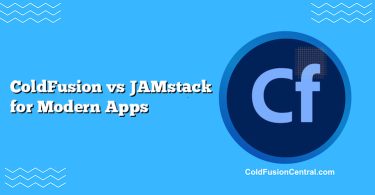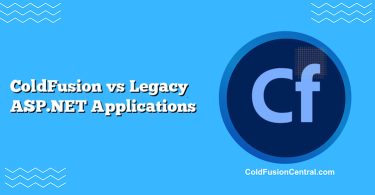Definitions
-
ColdFusion: A rapid web application development platform and runtime built around the CFML language. Available as Adobe ColdFusion (commercial) and Lucee (open-source), it runs on a Java servlet container (often Tomcat) and provides high-level services such as database access, PDF generation, scheduled tasks, mail, caching, REST, and security tooling out of the box.
-
On-Premises Web Servers: A deployment model where your web servers (e.g., Apache HTTP Server, Nginx, Microsoft IIS) run in your organization’s data center or private facilities. This is not a language or framework by itself but an infrastructure choice used to host apps written in stacks like .NET, Java, PHP, Node.js, Python, or even ColdFusion.
Overview
Comparing ColdFusion to on-premises web servers can feel like apples to oranges. ColdFusion is an application server and development ecosystem; “on-premises web servers” refers to where your web stack is hosted. Still, organizations routinely make a choice that sounds like “ColdFusion vs. on-prem,” which usually means:
- Use ColdFusion (Adobe CF or Lucee) as your application platform (which can itself be deployed on-prem or in the cloud).
- Or build and host apps using a general-purpose on-premises web server stack (IIS/ASP.NET, Apache/PHP, Nginx/Node.js, Java/Tomcat, etc.), possibly without ColdFusion.
This article explains each, highlights trade-offs, and helps you decide based on performance, scalability, security, cost, ecosystem, and compliance.
Key Features
ColdFusion Highlights (Adobe CF and Lucee)
- Rapid application development with CFML (tag-based and script syntax).
- Built-in services: mail, PDF, image manipulation, scheduler, ORM (Hibernate), WebSocket, REST, caching, JDBC pooling, full-text search (via extensions), and security hardening guides.
- Seamless integration with Java libraries; deployable on Tomcat or other servlet engines.
- Administration consoles for server and datasource configuration.
- Commercial support (Adobe) or open-source flexibility (Lucee).
On-Premises Web Servers Highlights
- Choice of server: Apache HTTP Server, Nginx, Microsoft IIS.
- Choice of runtime: .NET, Java, PHP, Node.js, Python, Ruby, Go.
- Full control over hardware, network, storage, data residency, and compliance (e.g., PCI DSS, HIPAA, GDPR).
- Works with reverse proxies, WAFs, and load balancers in your data center.
- Can host ColdFusion as well as any other runtime.
Architecture and Deployment Models
ColdFusion Runtime Model
- Runs as a Java application on a servlet container (usually Tomcat).
- Application code in CFML, optionally mixing tags (
) and script (queryExecute()). - Typically fronted by a web server (IIS/Apache/Nginx) via connectors for static assets and SSL termination.
- Works on-prem, in cloud VMs, or containers (Docker/Kubernetes).
On-Premises Server Model
- Web server (IIS/Apache/Nginx) serves static content and proxies to app runtimes:
- .NET on IIS
- Java on Tomcat/Jetty/WildFly
- PHP via FPM/Apache module
- Node.js via reverse proxy
- Integrated with enterprise services: LDAP/AD, SIEM, centralized logging, backups, and hardware HSMs.
- You own the rack, power, cooling, and capacity planning.
Supported Platforms (quick view)
- ColdFusion: Windows, Linux, container images; Java-based (JDK compatibility), works with IIS/Apache/Nginx front-ends.
- On-Prem Servers: Windows Server (IIS), Linux (Apache/Nginx), BSD variants; hardware or virtualized via VMware/Hyper-V; can include Kubernetes on-prem.
Performance
ColdFusion Performance Considerations
- Built-in query caching, object caching (ehcache/Redis), and bytecode compilation via the JVM.
- Mature JDBC connection pooling and CFML-level optimizations (e.g., saved queries, struct/list functions).
- PDF/image functions can be CPU-heavy; consider offloading to microservices in high-throughput scenarios.
- Tuning approach:
- Set JVM heap, GC strategy (G1/ZGC), and thread pools.
- Use CF’s admin for datasource tuning and caching.
- Profile hotspots (FusionReactor, Java Flight Recorder).
- Introduce CDN and reverse proxy for static/offload.
On-Prem Performance Considerations
- Apache/Nginx are highly efficient for static content and TLS termination.
- IIS with HTTP.sys and ASP.NET Core Kestrel offers strong throughput on Windows.
- You can pick the runtime best suited to your workload (e.g., Node.js for streaming, JVM for CPU-bound tasks, Go for low-latency services).
- Tuning approach:
- Size hardware (CPU NUMA, NVMe, RAM, network).
- Optimize web server workers, keep-alives, TLS ciphers.
- Choose appropriate APM (New Relic, AppDynamics) and profiler per language.
- Scale horizontally with load balancers; shard or cache as needed.
Performance verdict: Both can be extremely fast when tuned. ColdFusion accelerates development; specialized runtimes may edge out in ultra-high-scale niches.
Scalability
- ColdFusion
- Vertical scale via JVM tuning and multi-instance ColdFusion deployments.
- Horizontal scale with sticky sessions or session replication (J2EE sessions), external session stores (Redis), and shared cache layers.
- Works well behind F5/Nginx/HAProxy with health checks.
- On-Prem Servers
- Traditional scale-up with bigger iron; scale-out via additional nodes.
- Choose stateless architectures in .NET/Java/Node, externalize state to cache/databases.
- On-prem Kubernetes or OpenShift enables container orchestration inside your data center.
Scalability verdict: Comparable, but polyglot on-prem stacks may offer more microservice language freedom.
Security
-
ColdFusion
- Security code analyzer, lockdown guides, sandboxing, secure profile.
- Built-in functions for hashing, encryption, and input validation.
- Adobe releases patches; Lucee community updates are frequent.
- Important to keep connector/web server hardened and disable unnecessary CF features in production.
-
On-Prem Servers
- Control over network segmentation, zero trust, and physical security.
- Web servers (IIS/Apache/Nginx) support modern TLS, HTTP/2/3, mTLS, HSTS, OCSP stapling.
- You manage OS patching, WAF policies, and vulnerability scanning end to end.
- Compliance is often easier when everything stays within your facilities and audit boundaries.
Security verdict: On-prem provides control and compliance proximity; ColdFusion provides secure-by-default features at the platform level. You can combine both.
Cost and Licensing
- ColdFusion (Adobe)
- Commercial license (Standard/Enterprise); cost-effective for teams that benefit from integrated features and official support.
- Reduces third-party purchases for PDF, scheduling, and similar utilities.
- Lucee
- Open-source CFML engine; lower licensing cost, community support; optional paid support via vendors.
- On-Prem Servers
- Hardware and facilities CAPEX, plus power, cooling, and ops staff OPEX.
- Server software often open-source (Apache/Nginx), but Windows Server + IIS may require licenses.
- Polyglot stacks can increase integration and maintenance costs.
Cost verdict: If you already run a data center, on-prem infra is a sunk/ongoing investment. ColdFusion can lower development and integration costs; Lucee reduces licensing but demands strong in-house expertise.
Community, Ecosystem, and Support
- ColdFusion
- Adobe support, long-term updates, security hotfixes; conferences and user groups.
- Lucee has an active OSS community, extensions, and docs.
- On-Prem Servers
- Massive ecosystems for .NET, Java, PHP, Node.js, and Python with extensive libraries and community help.
- Enterprise vendors for support (Microsoft, Red Hat, Oracle, NGINX F5, VMware).
Ecosystem verdict: On-prem polyglot gives you broader community reach; ColdFusion’s community is smaller but focused and provides higher-level abstractions.
Developer Experience and Language Notes
- CFML syntax options:
- Tag-based:
SELECT … - Script-based: result = queryExecute(“SELECT …”, params, {datasource=”…”})
- Tag-based:
- Built-in conveniences (cfhttp, cfmail, cfpdf, cfimage) mean fewer libraries to vet and wire.
- On-prem polyglot stacks allow choosing the best language per team (C#, Java, TypeScript, Python), but you’ll assemble features from multiple libraries and services.
Workflow comparison:
- ColdFusion: faster prototyping; simpler CRUD and reporting; strong admin console.
- On-Prem Polyglot: CI/CD with language-native tools; microservice-first; greater specialization per service.
Real-World Use Cases
-
When to prefer ColdFusion
- Rapid development for line-of-business apps, data-heavy reporting, internal portals, and forms-driven workflows.
- Teams with existing CFML expertise or needing built-in PDF/image/scheduler without managing multiple third-party components.
- Example: A regional bank builds a secure internal loan processing system on Adobe ColdFusion, integrating with Oracle via JDBC, generating PDFs, and scheduling nightly batch jobs—delivered in weeks instead of months.
-
When to prefer On-Prem Web Servers (without ColdFusion)
- Strict data residency and air-gapped environments; microservices with polyglot teams and language-specific SLAs.
- Extremely high-scale or specialized workloads where a specific runtime (Go, Rust, highly tuned Java) is chosen for performance.
- Example: A healthcare provider runs .NET APIs on IIS for EHR integration, with Nginx handling TLS and WAF rules, all inside a HIPAA-compliant on-prem network tied to an HSM.
Side-by-Side Comparison Table
| Dimension | ColdFusion (Adobe CF / Lucee) | On-Premises Web Servers (IIS/Apache/Nginx with .NET/Java/PHP/Node) |
|---|---|---|
| What it is | Application server + CFML language/runtime | Deployment model + choice of web servers and runtimes |
| Performance | Strong JVM-based performance; rapid I/O and caching; PDF/image can be CPU-heavy | Excellent, runtime-dependent; highly tunable per language and server |
| Scalability | Vertical + horizontal with session replication or external stores | Vertical + horizontal; microservices/polyglot flexibility |
| Security | Built-in hardening, sandboxing, platform patches | Full-stack control; enterprise WAF, TLS, segmentation, strict compliance |
| Cost | Adobe license or Lucee (OSS); lower integration cost for built-ins | Hardware, OS, and ops costs; software often OSS, Windows licensed |
| Use Cases | Rapid business apps, reporting, internal tools, integrations | Compliance-heavy environments, polyglot microservices, ultra-specialized workloads |
| Pros | Fast development; rich built-ins; admin console; Java interop | Total control; language choice; huge ecosystems; on-prem compliance |
| Cons | Smaller community; vendor licensing (Adobe); CFML skill availability | More integration work; ops complexity; potential tool sprawl |
Pros and Cons
ColdFusion Pros
- Rapid development via CFML and extensive built-in services.
- Stable JVM foundation; easy Java library integration.
- Lower need for third-party components for common tasks.
- Mature administrative tooling.
ColdFusion Cons
- Smaller talent pool than Java/.NET/Node.
- Adobe licensing costs (unless using Lucee).
- Perception of legacy if not communicated/maintained properly.
On-Premises Web Servers Pros
- Full control over infrastructure, security, and compliance.
- Choose the best language/runtime for each service.
- Large communities and vendor ecosystems.
- Can host ColdFusion as well as other stacks.
On-Premises Web Servers Cons
- Higher operational overhead and capacity planning.
- More pieces to integrate and maintain (APM, schedulers, PDF tools, etc.).
- Hardware refresh cycles and DR planning responsibilities.
Decision Factors / Which One Should You Choose?
Consider these questions:
- What’s your primary constraint?
- If speed to delivery and integrated capabilities matter most, choose ColdFusion.
- If compliance constraints and deep infra control drive everything, on-prem makes sense (and can still host CF).
- Team skills and hiring
- Strong CFML expertise or desire for rapid prototyping favors ColdFusion.
- A polyglot engineering team that prefers .NET/Java/Node may lean on on-prem stacks.
- Workload profile
- Document-heavy workflows and scheduled jobs favor ColdFusion’s built-ins.
- Streaming, real-time, or ultra-low-latency services might benefit from specialized runtimes in an on-prem stack.
- Budget and TCO
- Adobe CF license vs. assembling multiple third-party tools; Lucee reduces license but requires internal know-how.
- On-prem includes hardware, OS licensing (if applicable), and ops staffing; long-term CAPEX/OPEX must be accounted for.
- Modernization path
- ColdFusion can be containerized and scaled with Kubernetes.
- On-prem stacks can adopt microservices gradually; you can also mix ColdFusion services with .NET/Java/Node microservices.
Practical guidance:
- For greenfield internal business apps with tight deadlines: start with ColdFusion (Adobe CF or Lucee).
- For platforms requiring strict boundary controls, integration with existing Windows AD, and standardized .NET governance: choose on-prem IIS/.NET.
- Hybrid is common: a ColdFusion app for line-of-business features coexisting with on-prem microservices for specialty tasks.
Key Takeaways
- ColdFusion is an application platform; on-premises web servers are a deployment choice. You can use them together.
- Choose ColdFusion for rapid delivery, built-in features, and a cohesive admin experience.
- Choose on-prem stacks when you need granular infra control, polyglot flexibility, or must satisfy stringent compliance inside your data center.
- Performance and scalability can be excellent in both models; optimization and architecture matter more than labels.
- A hybrid approach often wins: ColdFusion for what it accelerates, on-prem microservices where specialization pays off.
FAQ
Can ColdFusion run on on-premises web servers?
Yes. ColdFusion (Adobe CF or Lucee) commonly runs behind IIS, Apache, or Nginx on-prem. The web server acts as a front-end, and ColdFusion runs on a Java servlet container (typically Tomcat).
Is Lucee a drop-in replacement for Adobe ColdFusion?
Lucee implements CFML and is compatible with a large subset of Adobe CF, but not 100%. Most apps migrate with minimal changes, yet features like certain PDF operations or admin-specific settings may require adjustments or extensions.
How does security compare between ColdFusion and on-prem stacks?
ColdFusion provides platform-level hardening and security features; on-prem stacks provide infrastructure-level control. Combining them—hardened ColdFusion behind a secure, well-configured on-prem web server—yields strong defense-in-depth.
What about containerization and Kubernetes?
Both ColdFusion and on-prem stacks can be containerized. You can run ColdFusion images in Kubernetes, and you can run IIS/ASP.NET, Nginx, or Apache containers on-prem via Kubernetes or OpenShift.
When should I avoid ColdFusion?
If your team is committed to a single non-CFML ecosystem (e.g., all-in on ASP.NET Core or Spring Boot) and you don’t need ColdFusion’s built-ins, the marginal benefit may be lower. Likewise, for workloads requiring highly specialized runtimes (e.g., ultra-low-latency Go services), a different stack may be better suited.




